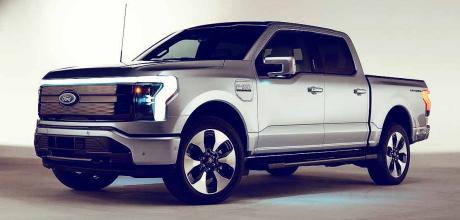All new 2022 Ford F-150 Lightning - Electric Pickup has a low price, and super tech specs
Ford’s EV pick-up marks a turning point in electric acceptance, but when will Australia join in?
FORD’S LIGHTNING STRIKES
EV pick-up has got US buyers amped, so why is Oz nowhere when it comes to an electric version of our top-selling vehicle?
The best-selling vehicle in America, the Ford F-Series is now available as an EV, and our Stateside friends are absolutely lapping it up. But, as we’ll get to in a moment, Australia’s car companies aren’t even talking about EV utes yet, and likely won’t be for some time.
In the USA, in just one week, more than 70,000 orders were placed for the Ford F-150 Lighting, a vehicle at polar opposites to the gas-guzzling stereotype we might associate with this segment. For context, consider that Ford sold 203,797 F-Series trucks for the first three months of 2021, so Lightning needed only seven days to account for over one third of F-Series’ quarterly sales.
It’s a significant shift for the EV segment in the USA, which, up until Ford’s entry, has been dominated by Tesla, with the Chevrolet Bolt and Nissan’s Leaf picking up the scraps.
So what’s got America’s vast middle class so ready to embrace the Lightning? For starters, affordability. The less-luxo version, called Pro, is priced just under US$40,000 (before government incentives), which is a mere US$3300 more than the equivalent entry-level, petrol-powered F-150. Yet the Pro features electric motors on each axle to develop 318kW and 1051Nm, and can travel up to a claimed 370km on a charge.
Opting for the larger Extended Range battery ups the price to US$49,974 (A$64,200), but bum outputs to 420kW and 1051Nm, cuts the 0-100km/h sprint time to under five seconds, and increases claimed range to 483km.
So could Aussie buyers follow America’s lead and embrace EV utes? Well, Lightning won’t be the vehicle to do it, as it’s not built in RHD. But utes do make up around 20 percent of Australia’s new-car market, so surely the potential exists.
Ask Ford, though, and the simple answer is: not for some time. Global CEO of the Blue Oval, Jim Farley, says since dual-cabs are so popular here as diesels, and Australia’s charging infrastructure is not mature, it’s hard to make a case for EVs.
“Infrastructure would have to improve in places like South Africa and Australia,” he told The Verge’s Decoder podcast, “I think it will take some time for those markets to move to full electric.”
Meanwhile, Ford Australia Product Communications Manager Ben Nightingale tells Wheels EV utes are coming, but they are years away. “Globally, Ford is investing almost A$39 billion in electrified vehicles through to 2025,” he says. “Electric vehicles are a big part of our future,” but the brand is “taking a considered approach to electrification” and will reveal more electrifie d model news “in due course.”
Wheels understands, though it’s unconfirmed, that even though the next Ranger will be engineered to be PHEV capable (see below) Australia won’t have access to it as a hybrid from the get-go.
As for the other big Aussie players in the dual-cab segment, Toyota is revealing nothing about its Hilux plans, choosing not to comment when approached by Drives.Today.
Volkswagen, for which the Amarok ute is its second-best-selling model behind Golf, also told Wheels there isn’t anything to discuss at this stage. Will the success of the F-150 Lighting provide momentum for other brands to fast-track EV pickup development? The benefits are obvious, from packaging (no engine allows for a huge lockable storage frunk in addition to the tray) to performance, with the F-150 Lighting confirmed to be quicker than the third-gen US-market Raptor.
Oh, and yes, electric vehicles can tow. Depending on the variant, Ford claims a maximum braked towing figure of 4536kg for Lightning, and a maximum payload of 907kg. But for now, it seems boutique upstarts like Bollinger and Rivian may deliver EV pick-ups in Oz before many of the major OEMs.
Above: Huge portrait touchscreen shows just how far F-150 has come from its bluecollar roots.
Could Aussie buyers follow America’s lead and embrace EV utes?


